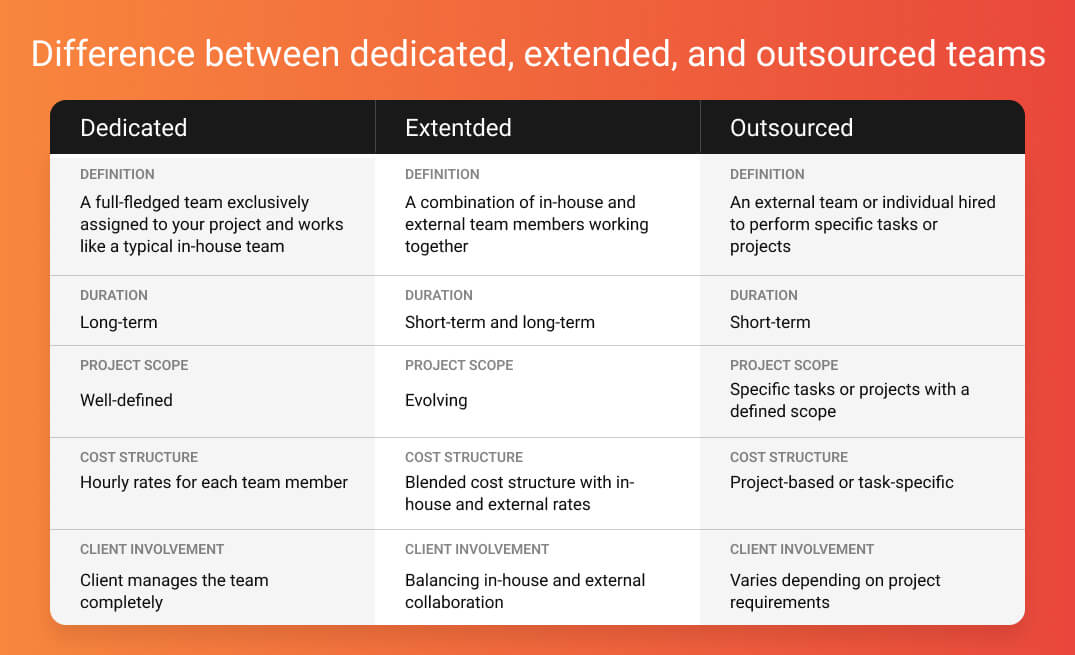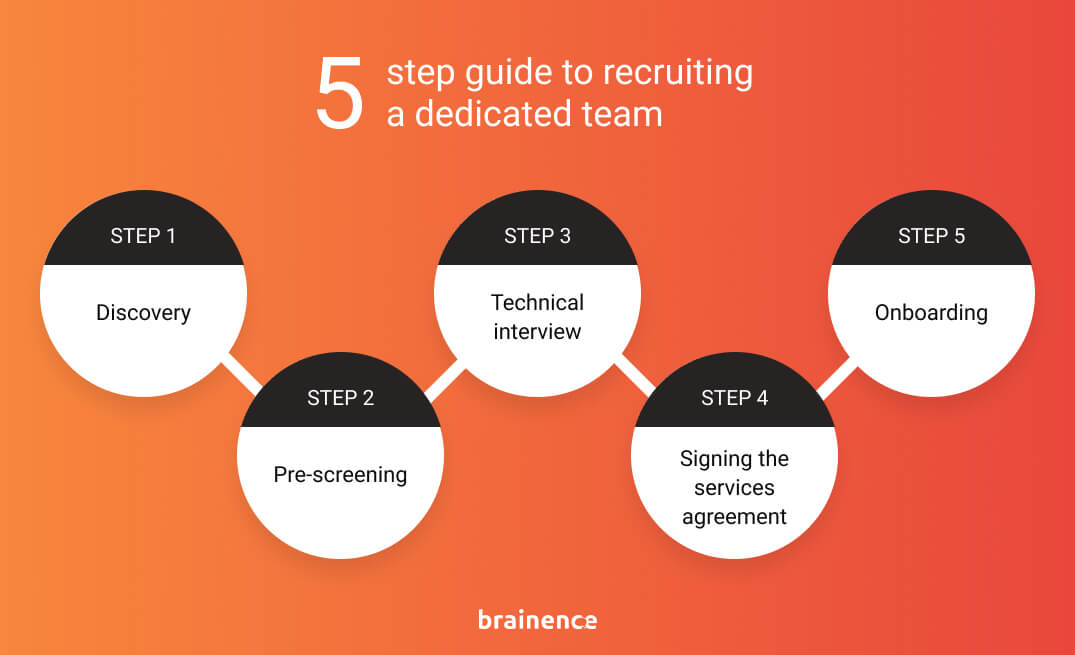23 February 2024
How to hire a best-in-class dedicated development team: a guide from Brainence’s experience
Set up your dedicated development team for long-term success. Here’s how to build yours from scratch.

Solutions
Author

Romanna Pastyrska
WriterAs your business grows, so does the need to level up your development team. While celebrating your product’s success, get ready to navigate through challenges that come with scaling—limited resources, tight timelines, and rapidly changing requirements.
The constant need for tech talents can slow down your progress, especially when managing multiple hiring steps, payroll responsibilities, and staff retention concerns.
The savvy solution? Hire a dedicated team. This collaboration model pays off if you need to:
- Scale up quickly
- Maintain control over the development process
- Avoid a lengthy hiring process
- Ease the administrative load.
This is where Brainence steps in. Having 7+ years of experience hiring dedicated teams, we can help you secure top talents for your development needs.
This article explores the reasons and ways to hire a dedicated team, places where to find the top talents, and guides you through the recruiting process and hiring costs. Read on!
What is a dedicated software development team?
A dedicated development team operates much like an in-house team. It is a long-term project-based collaboration model between you and an outsourced team.
“Dedicated” implies that the development team is hand-picked to work exclusively on the project—remotely and full-time.
Team composition
Is a dedicated development team limited to developers? No. The final team composition is approved after defining the project requirements, and it typically includes the following roles:
- Developers (front-end, back-end, full-stack, mobile)
- System architects
- Product designers
- Quality assurance specialists
- DevOps engineers
- Business analysts
- Product managers
- Project managers.
Difference between dedicated, extended, and outsourced teams
We’ve noticed that people find it challenging to grasp the difference between dedicated, extended, and outsourced teams. Let’s clear that up once and for all:

Some well-known companies that hire dedicated teams include Zapier, Slack, GitLab, Apple, Oracle, American Express, IBM, Verizon, and Amazon.
Many of these companies see remote work as a business advantage that provides many benefits. For example, Zapier’s team works from 13 countries, while an outsourced team developed Slack’s web interface and mobile apps.
Is the dedicated team the right model for your business?
Whether or not a dedicated team will work for you depends entirely on your specific business goals. The dedicated team model is a great fit for you if you:
Need to scale fast
If you’re aiming for a swift market entry or need to enhance your product quickly to meet business demands, supplementing your team with remote specialists ensures project momentum.
Require flexibility
Dedicated teams, inherently flexible, operate on leading-edge technologies. Beyond adapting to changes, they proactively identify and introduce evolving technologies crucial to your project.
Lack the tech expertise
If your in-house team lacks the required tech expertise or your project demands specialized skills that are hard to find quickly, explore team extension services. This allows you to augment your current team with the necessary tech expertise, getting the job done without extensive candidate searches or re-training efforts.
Have no hiring experience
Navigating the complexities of hiring without prior experience and an automated talent sourcing toolset can be challenging. If you’re facing difficulties in expanding your team or wish to bypass recruitment challenges, connecting with a team extension vendor is a smart move. Onboarding a dedicated team shifts much of the hiring process to the software development company, easing your recruitment burden.
Aren’t ready to scale your in-house team
Expanding your in-house team involves setting up workspaces, providing equipment, investing in onboarding, and handling paperwork—costly and time-consuming processes. Opting for a dedicated team, on the contrary, helps cut overhead costs. Remote team members, specifically assigned to your project, handle tasks without the need for physical presence.
You should NOT consider the dedicated team model if:
Your project is short-term or implies strict requirements
A dedicated software development team is unnecessary for small, short-term projects with a defined scope and chosen tech stack. If you have a precise understanding of your needs, consider a fixed-price arrangement with outsourced developers – a couple of freelancers might suffice.
You have a budget or time limitations
If you’re working with a tight budget or facing tight deadlines, a dedicated full-time software development team might not be necessary. In such cases, consider choosing a fixed-price model and pay for the specific workload needed.
Looking to hire a dedicated team?

5 reasons why opting for a dedicated team pays off
1. Saving costs
A dedicated team model provides clear cost tracking. Each employee has a fixed hourly fee, and you only pay for the hours worked at the agreed-upon rates.
You’re spared from dealing with administrative and legal matters. In contrast, setting up your in-house development team involves expenses like:
- Paying recruiters and HR specialists for recruitment and onboarding
- Renting an office, covering maintenance bills, purchasing equipment, hardware, and software
- Paying taxes, bonuses, insurance, and other social benefits.
2. Access to global talent
Relying solely on local resources might limit your possibilities. Luckily, distance is no longer a constraint for your business to engage an extensive and diverse range of professionals.
For instance, if you’re looking for a full-stack unicorn experienced in back-end development, front-end development, and architecting cloud environments, the search across your city or even country might be pointless.
Since the start of the 2020 pandemic, we’ve already gotten used to the peculiarities of remote work. Most companies structure their operations so that different time zones provide the advantage of an almost round-the-clock non-stop working process.
At Brainence, we have a defined process of working with companies across the globe.
3. 100% team engagement
By choosing a full-time team, you can be confident that the experts you hired will work exclusively for your tasks. On the contrary to other outsourcing models where IT specialists switch between assignments of different clients, your dedicated teammates are focused on your tasks only and are as engaged and motivated as your own employees.
4. Simplified management
Companies often hire dedicated teams along with a project manager to ensure the development and management processes work smoothly. This position is necessary to liberate the business owner from routine tasks like monitoring and reports, as the PM covers everything.
5. Transparency
An additional benefit is full transparency of the work process. Your team is likely to use software like Jira or Slack to communicate and set tasks, so you can be updated on the progress at any time. At Brainence, we ensure timely progress tracking.
Common concerns when hiring a dedicated development team
When embarking on the journey of hiring a dedicated development team, various concerns may arise, warranting careful consideration to ensure a successful collaboration. Here are some common concerns to address:
Communication barriers
Effective communication is crucial for project success. Concerns may arise regarding language proficiency and cultural differences. To mitigate this, thorough communication strategies and selecting teams with strong language skills and cultural awareness are essential.
Data security
Protecting sensitive data is a paramount concern. Businesses often worry about the security measures in place when working with a remote team. Establishing clear data security protocols, including non-disclosure agreements and secure communication channels, is crucial to alleviate these concerns.
Time zone differences
Collaborating across different time zones can pose challenges in terms of project coordination and communication. Addressing this concern involves setting clear expectations, establishing overlapping work hours, and leveraging project management tools to streamline communication.
Scalability and flexibility
Businesses may be concerned about the scalability and flexibility of a dedicated team. Ensuring that the chosen team can adapt to changing project requirements and scale up or down as needed is vital for long-term success.
Cost management
Managing costs effectively without compromising on quality is a constant concern. Transparent pricing models, clear contracts, and regular communication on project expenditures help alleviate worries about budget overruns.
5-step guide to recruiting a dedicated team
Hiring a single professional who matches your needs and fits your company culture is complicated. Now imagine assembling a team of perfectly talented teammates with skills that complement each other within a month.
Mission impossible? Not with the right partner.
At Brainence, we follow a tried and tested hiring process that gets you the right candidates within four weeks. Read on to find out the hiring steps and timeline.

Step 1. Discovery
Start with a kick-off meeting to gather requirements, expectations, and detailed project and company information. Agree on job titles, salary ranges, hiring stages, and timelines. Next, develop a sourcing strategy and validate it with stakeholders.
Expect to receive the initial shortlist of candidates within 5 to 7 days.
Step 2. Pre-screening
Analyze the candidate database for technical expertise, previous experience, English proficiency, and soft skills. For instance, Brainence has over 150,000+ candidates to choose from.
Within 72 hours, you get the CVs of the top three suitable candidates for your review. Based on your feedback, recruiters schedule and conduct pre-screening interviews.
Step 3. Technical interview
Within the next week, promising applicants advance to technical interviews. The experts on the vendor’s or client’s side (or both) meet the candidates to assess their skills, verify experience, and evaluate cultural fit to guarantee the right match.
Technical interviews are typically wrapped up between day 16 and day 25.
Step 4. Signing the service agreement
Offer positions to successful candidates within a week of the final interview. Signed offers are presented to you within the timeframe from day 26 to day 28.
Step 5. Onboarding
The client starts integrating new team members into the on-site team together with the provider’s HR team.
Important note:
Our clients are always concerned about scenarios where the candidate fails to fulfill their long-term needs. There is no single answer as probationary policies differ across companies.
At Brainence, new hires undergo a 90-day probationary period. Should a candidate not meet your requirements within this timeframe, we offer one free replacement.
Best platforms for hiring dedicated teams
Freelance platforms
To quickly fill a talent gap for routine or one-time tasks, we advise you to opt for freelancers. Check out these freelance platforms:
- Upwork
- Toptal
- Fiverr
- Freelancer
- PeoplePerHour
As you filter through over 211,000 tech candidates on Upwork or 3,000 vetted developers on Toptal, you can assess their portfolios and reviews, ultimately hiring professionals that your team lacks.
However, whether you like it or not, you’ll be responsible for coordinating tasks and managing the workflow. Also, since freelancers tend to work on multiple projects simultaneously, there may be a lack of long-term commitment, potentially leading to a breakdown in overall team cohesion.
B2B platforms
Filtering out dozens, if not hundreds, of potential candidates for software development, can take too much time. This is where B2B platforms come to the rescue, providing categorized lists of double-checked software development vendors, including verified client reviews.
Clutch
When you type in “software developers” on Clutch search, you access over 30,000 software development companies worldwide. Don’t be overwhelmed by the number—simply narrow down your search by specifying your exact needs.
For example, take a look at Brainence’s Clutch profile: average hourly rates, industry expertise, client reviews, and portfolio are all in one place.
Goodfirms
Goodfirms is another popular B2B research, rating, and review platform providing information on hundreds of software development companies. A convenient filter system allows you to narrow your search to just a few options that fit your business needs by sorting companies based on hourly rates, technologies, service types, and industry focus.
LinkedIn network
LinkedIn proves to be a powerful tool for professional networking and talent sourcing.
To narrow down potential tech vendors, use the LinkedIn search functionality. Using keywords, filters, and location preferences, you can identify professionals or companies that align with your specific criteria.
Evaluate companies’ size, location, and industry expertise, gaining insight into their overall performance. Also, check employee profiles to get a sense of their experience and background, making it easier to hire the software development team of your dreams. Finally, contact the most promising vendors and describe your needs.
Top locations for hiring dedicated teams
Decide which country or region you want to outsource your project to, and research companies in that area. If you’re going with more niche-specific tech expertise, be sure to find a company that has experience working with clients in your target industry. Here are the three most common locations for hiring dedicated teams.
Eastern Europe
Eastern Europe has emerged as a powerhouse for dedicated teams, offering a vast pool of highly skilled developers and IT professionals. Countries like Ukraine, Poland, and Romania are known for their technical expertise, language proficiency, and cultural alignment with Western businesses. The competitive pricing and strong work ethic make Eastern Europe an attractive destination for outsourcing.
Latin America
Latin America is gaining traction as a top destination for dedicated teams due to its cultural affinity with Western countries and a growing tech talent pool. Countries like Mexico, Brazil, and Argentina boast a workforce with a creative mindset, adaptability, and proficiency in multiple languages. Proximity to the Americas also facilitates better time zone alignment, fostering seamless collaboration.
Asia
Asia, particularly countries like India, has been a key player in the outsourcing landscape for years. Known for its extensive talent pool, India offers cost-effective solutions without compromising on quality. The strong educational focus on technical skills, coupled with a significant English-speaking population, makes it a go-to destination for businesses looking to scale their development teams.
Each of these regions brings unique advantages to the table, catering to different business needs and preferences. Ultimately, your choice depends on factors such as project requirements, budget considerations, and cultural alignment with the outsourcing destination.
Ready to scale? Hire your dedicated team.

How much will it cost you to hire a software development team?
Finally, the most intricate question. How much are you going to pay for your dedicated development team and is it more cost-effective than building your in-house team?
There is never a straight-away answer. The final project cost depends on the following factors:
- Team composition
- Seniority levels
- Tech stack
- Location
Average rates hover around $45 per hour, with monthly expenses typically falling between $5,000 and $25,000. For more complex projects, costs may exceed this range.
Note that no reputable company will provide the final project cost without digging deep into your project’s needs. The total costs can only be provided after a detailed assessment of your project’s unique requirements.
If you’re looking to hire a team of developers, drop us a line. Our specialists will get in touch with you to understand your project requirements and give you an estimate of the timeline, necessary team composition, and final project costs.
How to manage a dedicated team successfully?
The essence of a dedicated team model sounds easy. You just have to hire more software developers to assign certain tasks to them and let your in-house team get their job done without fuss. However, when it comes to practice, integrating, onboarding, and managing your augmented team becomes a little more challenging. Below are some tips for establishing effective collaboration between your in-house and dedicated teams from the beginning.
Set clear goals and expectations
Define clear goals and expectations from the outset. Communicate project objectives, timelines, and performance expectations to align the team with organizational objectives.
Establish regular communication channels and project control practices
Utilize various communication tools and platforms to facilitate seamless interaction. Regular project updates and team meetings help keep everyone informed and engaged.
Your team extension vendor is likely to have the communication and collaboration approaches that make remote work effective. Your task, in turn, is to discuss them in advance, ensuring you can communicate to an extended team, quickly adjust their work scope, and count on a quick response if the project’s course changes. Also, discuss the project management tools—in the perfect picture of the world, your dedicated team should be skilled with the ones you use in-house.
Set SMART KPIs
To make sure your dedicated team is as effective as you would like it to be, set SMART (specific, measurable, achievable, realistic, and time-bound) KPIs that will clearly show your remote developers’ performance and productivity. When setting key performance indicators for your remote team, keep in mind that lines of code, tasks closed, bugs fixed, or hours worked tell almost nothing about the actual value your extended team brings. Instead, measure their performance with such metrics as deployment frequency, lead time, cycle time, tasks-in-progress, and change failure rate.
Work on developers’ onboarding closely with your vendor
While your development vendor will do their best to bring in additional team members and introduce them to your workflows in the fastest way possible, this is the point where you have to be closely involved in an onboarding process. Before hiring a dedicated team, prepare onboarding plans and documentation, assign a person responsible for developers’ onboarding, and communicate the upcoming changes in the team structure to your in-house programmers.
Looking to hire a dedicated team?
Whether you need to save costs, access global talent, ensure team engagement, simplify management, or enhance transparency, a dedicated team offers a myriad of benefits.
Consulting with an experienced software development company makes all the difference. Brainence stands as a trusted partner for hiring dedicated teams to help you source and hire top talents to meet your project requirements and elevate your software solution. Feel free to contact us.
Contact us

The most impressive for me was the ability of the team to provide first-class development and meet all the deadlines.

The team proactively comes up with solutions and is eager to deliver high-quality development support.

I was blown away by the knowledge that Brainence has about web app development, UX and optimisation.

